
Mirbelia is a plant genus belonging to the family Fabaceae and is endemic to Australia, occurring in every mainland state except South Australia. Plants in the genus Mirbelia are prickly, perennial shrubs with simple, sometimes sharply-pointed leaves, or the leaves absent. The flowers are arranged singly or in groups in leaf axils or on the ends of branches, the sepals joined at the base with five teeth. The petals are usually red, orange, purplish or bluish and the fruit is an inflated pod.
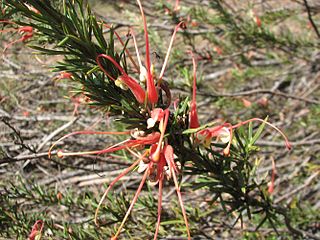
Grevillea tripartita is species of flowering plant in the family Proteaceae and is endemic to the south-west of Western Australia. It is an erect, prickly shrub with divided leaves with 3 lobes, and clusters of red and cream-coloured or reddish-orange and yellow flowers.

Grevillea florida is a species of flowering plant in the family Proteaceae and is endemic to the south-west of Western Australia. It is a erect, low shrub with linear to narrowly elliptic leaves, and clusters of hairy, white to creamy yellow flowers with a yellow- or orange-tipped style that ages to red.

Grevillea incrassata is a species of flowering plant in the family Proteaceae and is endemic to inland south-western Western Australia. It is an erect shrub with crowded cylindrical or narrowly linear leaves and clusters of bright yellow flowers.

Grevillea pauciflora, commonly known as the few-flowered grevillea, or as Port Lincoln grevillea in South Australia, is a species of flowering plant in the family Proteaceae and is endemic to the south of continental Australia. It is an erect to straggly or spreading shrub with linear to narrowly wedge-shaped leaves and red or orange flowers with a red or orange style.

Grevillea spinosa, commonly known as tjiilka-tjiilka, is species of flowering plant in the family Proteaceae and is endemic to inland Western Australia. It is a dense, prickly shrub with mostly pinnatipartite leaves with rigid, sharply-pointed linear lobes, and erect clusters of reddish to blackish green flowers with a bright yellow to orange style.

Grevillea yorkrakinensis is a species of flowering plant in the family Proteaceae and is endemic to the southwest of Western Australia. It is a small, compact, spreading shrub with linear leaves, and clusters of red to yellowish-orange flowers arranged in groups of up to 5, the styles red to yellow or greenish.

Marianthus tenuis is a species of flowering plant in the family Pittosporaceae and is endemic to the southwest of Western Australia. It is a slender, twining shrub with clustered, narrowly elliptic leaves and white flowers tinged with mauve and with darker spots on three of the five petals.

Pityrodia ternifolia is a species of flowering plant in the mint family, Lamiaceae and is endemic to north-western Australia. It is an erect shrub with densely hairy stems, sticky and prickly, egg-shaped leaves, and mauve or pinkish-red, tube-shaped flowers.
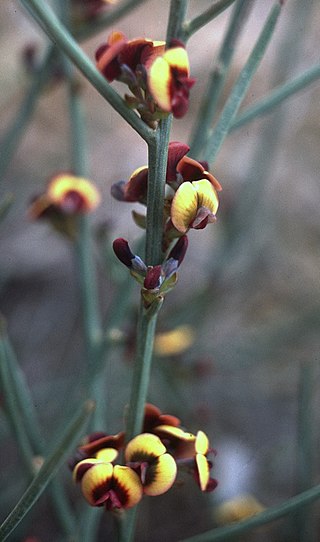
Daviesia debilior is a species of flowering plant in the family Fabaceae and is endemic to the south-west of Western Australia. It is a shrub with low-lying stems and many erect branchlets, scattered linear to scale-like phyllodes, and yellow, purplish, orange-pink and dark purplish flowers.
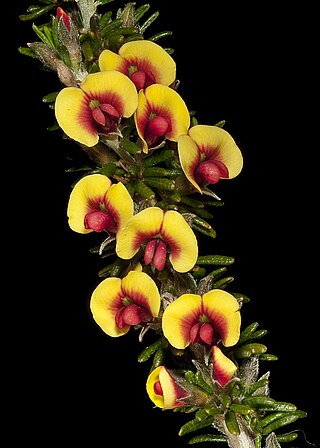
Mirbelia spinosa is a species of flowering plant in the family Fabaceae and is endemic to the south-west of Western Australia. It is a spiny shrub with narrowly linear leaves and yellow, orange and reddish-brown flowers.
Daviesia eremaea is a species of flowering plant in the family Fabaceae and is endemic to central Australia. It is an erect, glabrous, multi-stemmed shrub with needle-like, more or less sharply-pointed phyllodes, and yellow and red flowers.
Mirbelia corallina is a species of flowering plant in the family Fabaceae and is endemic to the far west of Western Australia. It is a slender, sprawling sub-shrub with a few narrowly elliptic to narrowly egg-shaped leaves and pink and yellow flowers arranged in racemes near the ends of the branchlets.
Mirbelia ferricola is a species of flowering plant in the family Fabaceae and is endemic to inland parts of the south-west of Western Australia. It is an erect shrub with leaves reduced to small scales, and red and yellow flowers arranged in racemes at the ends of the branches.
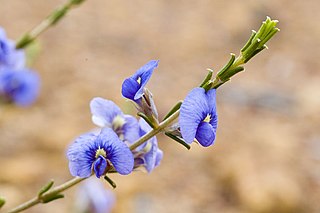
Mirbelia floribunda, commonly known as purple mirbelia, is a species of flowering plant in the family Fabaceae and is endemic to the south-west of Western Australia. It is an erect, slender or straggling, much-branched shrub with narrowly linear leaves and bluish-purple flowers.
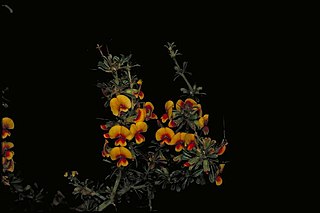
Mirbelia granitica is a species of flowering plant in the family Fabaceae and is endemic to inland areas of Western Australia. It is an erect or spreading shrub with spiny branches, scattered linear to narrowly egg-shaped leaves and yellow and red flowers.
Mirbelia stipitata is a species of flowering plant in the family Fabaceae and is endemic to inland areas of Western Australia. It is a spiny, more or less leafless shrub with yellow and red flowers.
Pimelea clavata is a species of flowering plant in the family Thymelaeaceae and is endemic to near-coastal areas and offshore islands of southern Western Australia. It is an erect shrub with narrowly elliptic to more or less linear leaves arranged in opposite pairs, and head-like clusters of white to pale yellow, tube-shaped flowers surrounded by leaf-like involucral bracts.
Pimelea forrestiana is a species of flowering plant in the family Thymelaeaceae and is endemic to Western Australia. It is a shrub with linear to narrowly elliptic leaves arranged in opposite pairs, and head-like clusters of yellow, tube-shaped flowers.

Pimelea leucantha is a species of flowering plant in the family Thymelaeaceae and is endemic to near-coastal areas in the west of Western Australia. It is a shrub with linear to narrowly egg-shaped or narrowly elliptic leaves and clusters of white to pale yellow flowers surrounded by 4 or 6 egg-shaped involucral bracts.













